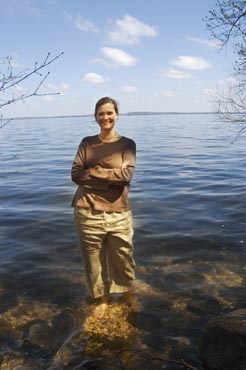Resident bacteria may help clean phosphorous from lakes
In recent years, Madison residents have focused new attention on water-quality problems ranging from beach closings to unsightly, odoriferous blue-green algae blooms caused by an overload of phosphorus within area lakes.

Civil and Environmental Engineering Assistant Professor Katherine (Trina) McMahon stands ankle-deep in the still-chilly water of Lake Mendota in April 2007. McMahon will draw on her research interests in both wastewater and freshwater to provide a unique perspective on how bacteria contribute to phosphorus cycling in eutrophied lakes, which often have severe water quality challenges such as algae blooms.
Photo: Jim Beal
In reality, those problems began in the city more than a century ago. They originated in an era when "wastewater treatment" meant dumping largely untreated sewage back into the lakes, says Katherine McMahon, a University of Wisconsin–Madison assistant professor of civil and environmental engineering. "Phosphorus is something that, once it gets into the lakes, it's very hard to get out," she says.
McMahon received a prestigious $400,000 National Science Foundation CAREER award, which provides early-career support for creative projects that integrate research and education, to investigate this water-quality challenge. She will use her expertise in wastewater engineering and in biological systems to study the bacterial community in different eutrophied lakes-two in Madison and one in China-to learn more about how those bacteria affect phosphorus cycling in the lakes.
In eutrophied lakes, or those contaminated with excess nutrients, phosphorus generally is trapped in the sediments at the bottom. In spring, the lake "turns over" and the phosphorus becomes a major ingredient in that giant, oxygen-rich mixing bowl. It's a recipe for an algae bloom.
In summer, cooler water far below the lake surface traps phosphorus on the lake bottom, where McMahon's previous research suggests that bacterial communities release it in a biological process similar to that which is responsible for enhanced biological phosphorus removal, or EBPR, a method often used during wastewater treatment.
In fact, McMahon will use new tools in molecular biology and recent research advances that apply to EBPR processes to help her develop hypotheses about how phosphorus is released into the water column by bacteria during the summer, and taken up during the spring and fall.
Traditionally, limnologists who study lake phosphorus group bacteria into a single "black box," says McMahon. Conversely, she seeks to identify specific bacterial populations present within eutrophic lakes, learn how those populations respond to changing lake conditions, and learn how they work as a community to cycle phosphorus.
For three years, she will collect weekly bacteria samples in multiple locations from Madison-area lakes Mendota and Wingra during ice-off seasons, as well as monthly samples when the lakes are frozen. Likewise, her collaborator, Guang Gao of the Nanjing Institute of Geography and Limnology, Chinese Academy of Sciences, will sample Lake Taihu, a large, shallow lake in Jiangsu Province that supplies drinking water to 40 million people in Shanghai and surrounding cities. "We are looking at the relationship between what types of bacteria are present and the availability of phosphorus in the water," says McMahon.
She and her students also will incubate water samples in the laboratory. In one experiment, they will add radioactive phosphorus that will help them track which bacteria are responsible for phosphorus recycling. Ultimately, McMahon hopes her research will contribute to a future solution to excess phosphorus in any lake. "Eutrophication of freshwater lakes is a problem everywhere in the developed world, and in many developing countries as well," she says.
Working with graduate students Ashley Shade and Ryan Newton, UW–Madison Center for Biology Education Outreach Program Director Robert Bohanan, and staff in the UW–Madison Center for the Integration of Research, Teaching and Learning, McMahon will expand her current middle-school outreach activities, which include activities that inspire students to think like environmental engineers, to include inquiry-based activities based on phosphorus-driven eutrophication.
In addition, she will develop a three-week summer workshop on microbes and water quality for underrepresented high school students who participate in the UW–Madison Pre-college Enrichment Opportunity Program for Learning Excellence (PEOPLE) program.
